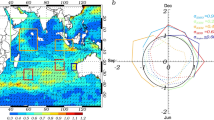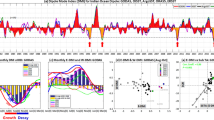Abstract
Southern Indian Ocean dipole (SIOD) is a dipole SST anomaly in the Southern Indian Ocean that plays an important role in tropical climate variability. However, previous studies focused on the interannual and interdecadal scales. In this paper, the characteristics on sub-seasonal scale of SIOD are revealed from December to February (DJF) based on the ERA-Interim reanalysis dataset, and the excitation mechanisms of SIOD are also discussed. The results show that the two dominant modes of SST in the Southern Indian Ocean are the spatial distribution of Southwest-Northeast direction dipole (SIOD) and triple (SIOT) respectively, which has obvious period of quasi 50–60 days. Moreover, the intensity and zonal oscillation of the Mascarene high are conducive to the formation of SIOD (SIOT). The air–sea interaction during the formation process is composed of three stages. In the first stage the atmospheric forces the ocean to result in the Mascarene high westward (eastward) and enhances the abnormal anticyclone in the Southern Indian Ocean. There are abnormal northerly (southerly) flows on the west (east) sides of the abnormal anticyclone respectively, which weakens (enhances) the southeast trade wind in the climatology. The surface latent heat flux release decreases (increases) and SST is warmed (cooled). During the following stage, the ocean feedback the atmosphere. The warm SST continues to increase, resulting in low-level convective enhancement, which weakens the abnormal anticyclone. The third stage is again the atmosphere forcing the ocean. The abnormal anticyclone gradually turns into an abnormal cyclone and the meridional wind direction is reversed. The release of the latent heat flux increases (decreases) significantly which leads to the cooling (warming) of SST on the west (east) sides of an abnormal cyclone. In addition, the formation and extinction of SIOT are easier affected by the southern annular mode (SAM) than SIOD. The abnormal zonal wave train with wavenumber 4 (3) propagates the Southern Indian Ocean by the westerly jet waveguide and results in an SST anomaly of SIOD (SIOT), accompanied by an obvious sub-seasonal meridional variation of the precipitation in Southern Africa.


















Similar content being viewed by others
References
Ambrizzi T, Hoskins BJ, Hsu HH (1995) Rossby wave propagation and teleconnection patterns in the austral Winter. J Atmos Sci 52(21):3661–3672. https://doi.org/10.1175/1520-0469(1995)052%3c3661:RWPATP%3e2.0.CO;2
Behera SK, Yamagata T (2001) Subtropical SST dipole events in the southern Indian Ocean. Geophys Res Lett 28(2):327–330. https://doi.org/10.1029/2000GL011451
Dee DP, Uppala SM, Simmons AJ et al (2011) The ERA-Interim reanalysis: configuration and performance of the data assimilation system. Q J R Meteorol Soc 137(656):553–597. https://doi.org/10.1002/qj.828
Hermes JC, Reason CJC (2005) Ocean model diagnosis of interannual coevolving SST variability in the South Indian and South Atlantic Oceans. J Clim 18(15):2864–2882. https://doi.org/10.1175/JCLI3422.1
Krishnamurthy V, Shukla J (1989) Intraseasonal and interannual variability of rainfall over India. J Clim 13(24):4366–4377. https://doi.org/10.1175/1520-0442(2000)013%3c0001:IAIVOR%3e2.0.CO;2
Li CY (1996) Further studies on evaporation-wind feedback. J Trop Meteorol 000(003):193–199 ((in Chinese))
Marshall GJ (2007) Half-century seasonal relationships between the Southern Annular Mode and Antarctic temperatures. Int J Climatol 27:373–383. https://doi.org/10.1002/joc.1407
Müller GV, Ambrizzi T (2007) Teleconnection patterns and rossby wave propagation associated to generalized frosts over southern south America. Clim Dyn 29:633–645. https://doi.org/10.1007/s00382-007-0253-x
Neelin JD, Held IM, Cook KH (1987) Evaporation-wind feedback and low-frequency variability in the tropical atmosphere. J Atmos Sci 44(16):2341–2348. https://doi.org/10.1175/1520-0469(1987)044%3c2341:EWFALF%3e2.0.CO;2
Rai S, Pandey AC (2008) Southern Indian Ocean SST variability and its relationship with Indian Summer monsoon. Atmos Ocean 46(3):361–376. https://doi.org/10.3137/ao.460305
Ramanathan V (1987) The role of earth radiation budget studies in climate and general circulation research. J Geophys Res Atmos 92(D4):4075–4095. https://doi.org/10.1029/JD092iD04p04075
Ramanathan V, Barksbm BR, Harrison EF (1989) Climate and the earth’s radiation budget. Phys Today 42(5):2232. https://doi.org/10.1063/1.881167
Reeder MJ, Spengler T, Musgrave R (2015) Rossby waves, extreme fronts, and wildfires in southeastern Australia. Geophys Res Lett 42(6):2015–2023. https://doi.org/10.1002/2015GL063125
Ren XJ, Yang DJ, Yang XQ (2015) Characteristics and mechanisms of the subseasonal eastward extension of the South Asian high. J Clim 28(17):6799–6822. https://doi.org/10.1175/JCLI-D-14-00682.1
Shahi NK, Rai S, Mishra N (2018) Southern Indian Ocean SST as a modulator for the progression of Indian Summer monsoon. Theor Appl Climatol 131:705–717. https://doi.org/10.1007/s00704-016-2004-6
Shun Q, Sugimoto S, Hanawa K (2015) Zonal movement of the Mascarene high in austral summer. Clim Dyn 45(7–8):1739–1745. https://doi.org/10.1007/s00382-014-2427-7
Suzuki R, Behera SK, Iizuka S et al (2004) Indian Ocean subtropical dipole simulated using a coupled general circulation model. J Geophys Res Oceans 109(9):638–646. https://doi.org/10.1029/2003JC001974
Thompson DWJ, Wallace JM (2000) Annular modes in the extratropical circulation. Part I: month-to-month variability. J Clim 13(5):1000–1016. https://doi.org/10.1175/1520-0442(2000)013<1000:AMITEC>2.0.CO;2
Thompson DWJ, Solomon S (2002) Interpretation of recent southern hemisphere climate change. Science 296:895–899. https://doi.org/10.1126/science.1069270
Tozer CR, Risbey JS, O’Kane TJ, Monselesan DP, Pook MJ (2018) The relationship between wave trains in the southern hemisphere storm track and rainfall extremes over Tasmania. Mon Weather Rev 146:4201–4230. https://doi.org/10.1175/MWR-D-18-0135.1
Tripathi KC, Rai S, Pandey AC, Das IML (2008) Southern Indian Ocean SST indices as early predictors of Indian Summer monsoon. Indian J Geo Mar Sci 37(1):70–76
Wang LJ, Chen S, Zhang HY (2018) Characteristics of Southern Indian Ocean dipole variation and its relationship with ENSO events. Trans Atmos Sci 41(3):344–354. https://doi.org/10.13878/j.cnki.dqkxxb.20170221003 (in Chinese)
Xie S, Annamalai H, Schott FA, McCreary JP (2002) Structure and mechanisms of South Indian Ocean climate variability. J Clim 15(8):864–878. https://doi.org/10.1175/1520-0442(2002)015%3c0864:SAMOSI%3e2.0.CO;2
Xu HM, Zhang L, Du Y (2013) Research progress of southern Indian Ocean dipole and its influence. J Trop Oceanogr 32(1):1–7. https://doi.org/10.3969/j.issn.1009-5470.2013.01.001 (in Chinese)
Yan HM, Li CY, Zhou W (2009) Influence of subtropical dipole pattern in southern Indian Ocean on ENSO event. Chin J Geophys 52(10):2436–2449. https://doi.org/10.3969/j.issn.0001-5733.2009.10.003 (in Chinese)
Yan HM, Zi YC (2021) Characteristics of the subseasonal-scale zonal movement of subtropical high in summer and its relationship with precipitation in Southwest China. Chin J Atmos Sci 45(1):1–20. https://doi.org/10.3878/j.issn.1006-9895.2003.19204 (in Chinese)
Yang QM (2006) Indian Ocean subtropical dipole and variations of global circulations and rainfall in China. Acta Oceanol Sin 28(3):47–56 ((in Chinese))
Yoo SH, Yang S, Ho CH (2006) Variability of the Indian Ocean sea surface temperature and its impacts on Asian–Australian monsoon climate. J Geophys Res Atmos 111:630–637. https://doi.org/10.1029/2005JD006001
Yushi M, Takaya K, Behera SK, Masumoto Y (2015) Local SST impacts on the summertime Mascarene high variability. J Clim 28(2):678–694. https://doi.org/10.1175/JCLI-D-14-00133.1
Zhang L, Du Y, Zhang HY et al (2014) Characteristics of Southern Indian Ocean dipole and its relationships with ENSO. Trans Atmos Sci 37(6):695–704. https://doi.org/10.13878/j.cnki.dqkxxb.20120403003(in Chinese)
Zhou TJ, Yu RC, Li W, Zhang XH (2001) On the variability of the Indian ocean during the 20th century. Acta Meteor Sin 59:257–269 ((in Chinese))
Zi YC, Xiao ZN, Yan HM, Xu JJ (2022) Sub-seasonal east–west oscillation of the Western Pacific subtropical high in summer and its air–sea coupling process. Clim Dyn 58:115–135. https://doi.org/10.1007/s00382-021-05893-8
Zolotov SY, Ippolitov II. Loginov SV (2015) Climate changes in the Southern Hemisphere subtropical jet stream during the second half of the XX century—the beginning of XXI century. In: 21st international symposium atmospheric and ocean optics: atmospheric physics, p 96806O. https://doi.org/10.1117/12.2205758
Acknowledgements
This research was jointly supported by the Strategic Priority Research Program of Chinese Academy of Sciences (Grant number XDA20060501) and the National Natural Science Foundation of China (U1902209).
Funding
Funding provided by Strategic Priority Research Program of Chinese Academy of Sciences (XDA20060501) and National Natural Science Foundation of China (U1902209).
Author information
Authors and Affiliations
Corresponding author
Additional information
Publisher's Note
Springer Nature remains neutral with regard to jurisdictional claims in published maps and institutional affiliations.
Rights and permissions
Springer Nature or its licensor (e.g. a society or other partner) holds exclusive rights to this article under a publishing agreement with the author(s) or other rightsholder(s); author self-archiving of the accepted manuscript version of this article is solely governed by the terms of such publishing agreement and applicable law.
About this article
Cite this article
Zi, Y., Xiao, Z., Lu, G. et al. A sub-seasonal oscillation of sea surface temperature in the Southern Indian Ocean during DJF and its excitation mechanism. Clim Dyn 60, 3927–3945 (2023). https://doi.org/10.1007/s00382-022-06538-0
Received:
Accepted:
Published:
Issue Date:
DOI: https://doi.org/10.1007/s00382-022-06538-0




